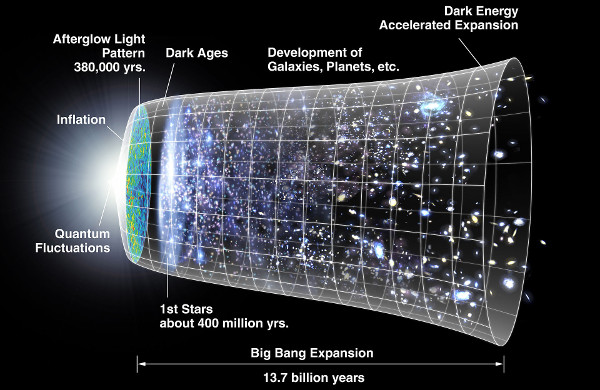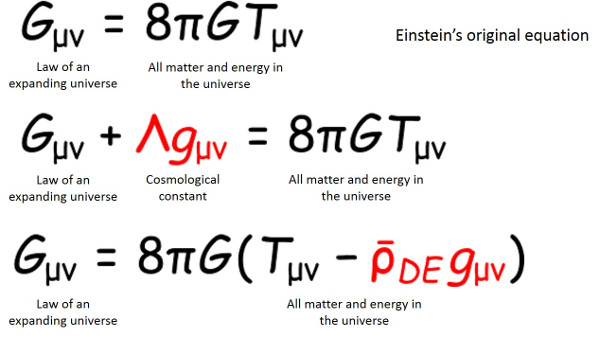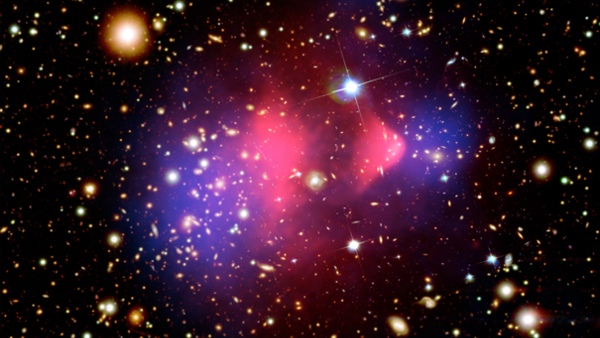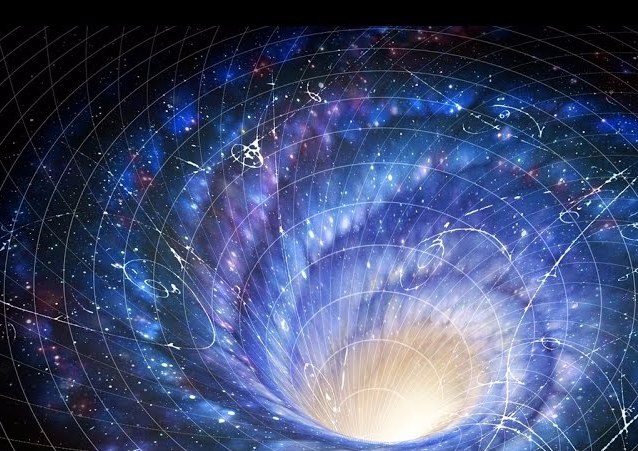Dark energy and dark matter may not exist as scientists believe for nearly a century
A new study shows that the theory that scientists still believe in nearly a century: dark energy accounts for more than 68% and dark matter accounts for 27% of the universe, the planets and why only occupy about 5% is not correct.
- New research confirms: The mystery of "dark energy" may not exist
- After all the mysterious material that occupies more than half of the universe hidden for billions of years has been discovered
Scientists believe that dark energy, which promotes the acceleration of the universe's expansion, is stronger than gravity and dark matter, which makes stars move. These are two of the biggest mysteries of astronomy.

But a researcher from the University of Geneva (UNIGE) in Switzerland has illustrated phenomena without the need for dark matter and dark energy. Accordingly, the two concepts of dark matter and dark energy are no longer reasonable.
According to Science Daily, the universe and evolutionary history are characterized by equations in Einstein's general theory of relativity, quantum mechanics and Newton's universal gravitation. The current central universe model is big bang and expansion.
 Traditional universe model.
Traditional universe model.
According to André Maeder, emeritus professor of astronomy at UNIGE, the traditional model does not take into account the scale variation of empty space, which forms Einstein's relatively broad equations, which are expressed by a number often called "cosmological constant".

Einstein's relatively broad original equation.(Photo: UTokyo Research).
Maeder has changed the assumption of empty space in the old model from constants to variables to build and test three new models.
The first model was built based on Einstein's general theory of relativity , physical equations that included accelerating expansion of the universe. The calculation results are consistent with the observations. This model does not need dark energy elements or molecular energy but still predicts the accelerating expansion of the universe.
The second test is based on Newton's gravity (a specific version of the relatively wide equations) applied to galaxy clusters. This model can explain the high speed of galaxies in galaxy clusters without the need for dark matter.
The third experiment examined the speed dispersion of stars around the Milky Way galaxy, the galaxy that contains the Earth. This speed dispersion is clearly explained based on the traditional null (unchanging) null space hypothesis. This unique result is something that science has yet to agree on.

Professor André Maeder's new discovery will pave the way for a new concept that raises questions and controversies in astronomy. He said that dark matter and dark energy, two of the universe's greatest mysteries were finally decoded.
The study was published in the Astrophysical Journal physical astrophysical journal.
Historical discovery, dark matter research and dark energy
In 1933, Fritz Zwicky, a Swiss astronomer announced a world-shocking discovery: the universe has more matter than what we have seen in reality and that matter is called dark matter.
By the 1970s, American astronomer Vera Rubin used the concept of dark matter to explain the movement and speed of stars making it even more important.
In 1998, a group of Australian and American astrophysicists discovered the acceleration of the expanding universe and were called dark energy that was thought to be stronger than Newton's gravity. This discovery is again the second shocking world and it was awarded the Nobel Prize for Physics in 2011.
Since its discovery, scientists have done a lot of research to determine dark matter and dark energy but all have no results. They have become two mysteries that have challenged astronomers for almost a century.

In April this year, a group of Hungarian scientists also published a hypothesis that the new model of the universe does not need dark energy. This theory considers the density of the universe to be different, so the expansion of the universe is also different. The calculation results also show that this model is consistent with general relativity and also explains the expansion of the universe without dark energy.
See also: Dark matter, dark energy and unexplored mysteries
You should read it
- After all the mysterious material that occupies more than half of the universe hidden for billions of years has been discovered
- The 9 biggest mysteries of modern physics make scientists headaches (Part 1)
- Beautiful Cosmic Background, download Beautiful Cosmic Background here
- The most impressive cosmic images 2019
- Asgardia - What is special about the first cosmopolitan country in the world?
- Discover incredible facts about our cosmic planet
- Latest Cosmic Chaos Code
- Elements of the universe
May be interested
- The 9 biggest mysteries of modern physics make scientists headaches (Part 1)
 the physical knowledge of the universe is immense. each new physical discovery opens up deeper, larger questions about physics.
the physical knowledge of the universe is immense. each new physical discovery opens up deeper, larger questions about physics. - Astronomers create the most accurate map of all matter in the universe
 of the tens of thousands of conundrums facing astronomers today, the biggest unknown is probably about the matter that makes up most of the universe.
of the tens of thousands of conundrums facing astronomers today, the biggest unknown is probably about the matter that makes up most of the universe. - 9 amazing facts about the universe amaze you
 the vast universe contains countless mysteries waiting for people to discover. how many stars in the universe, how the earth is shaped ... are the mysteries of the universe that have a strong attraction to all those who love to explore the universe.
the vast universe contains countless mysteries waiting for people to discover. how many stars in the universe, how the earth is shaped ... are the mysteries of the universe that have a strong attraction to all those who love to explore the universe. - What is Dark Web? Who uses it? The potential dangers of Dark Web and warnings
 what is dark web? what content does dark web contain? it must be a question that makes many people feel curious. read this article to learn more about dark web, the potential dangers of the ice block's iceberg and the dark web approach.
what is dark web? what content does dark web contain? it must be a question that makes many people feel curious. read this article to learn more about dark web, the potential dangers of the ice block's iceberg and the dark web approach. - Li explained the law of conserving energy with just one coin
 energy is a wonderful thing, exists around our lives, from energy that sustains life for people to energy to generate electricity ... but to answer what energy is, not everyone give the correct answer.
energy is a wonderful thing, exists around our lives, from energy that sustains life for people to energy to generate electricity ... but to answer what energy is, not everyone give the correct answer. - 'Giant atoms' swallow other atoms to create a new state of matter
 as scientifically proven, there is always a relatively large empty space inside an atom. now, scientists from austria and the united states have filled some of these gaps, creating a new state of matter in the form of giant atoms filled with other atoms.
as scientifically proven, there is always a relatively large empty space inside an atom. now, scientists from austria and the united states have filled some of these gaps, creating a new state of matter in the form of giant atoms filled with other atoms. - Should you use a VPN on the Dark Web?
 are vpns only useful for staying anonymous on regular websites and apps? if you're looking to dig deeper and access the dark web, is it worth using a vpn?
are vpns only useful for staying anonymous on regular websites and apps? if you're looking to dig deeper and access the dark web, is it worth using a vpn? - How to Use the Dark Web Without Doing Anything Illegal
 the dark web has a bad reputation, but you can learn to navigate it safely for legitimate research and privacy purposes—without breaking any laws.
the dark web has a bad reputation, but you can learn to navigate it safely for legitimate research and privacy purposes—without breaking any laws. - The Dark Web is not illegal, but be wary of these 7 things!
 the dark web is a mysterious place with a notorious reputation. finding the dark web isn't difficult. however, learning how to navigate it safely is another story, especially if you don't know what you're doing or what to expect.
the dark web is a mysterious place with a notorious reputation. finding the dark web isn't difficult. however, learning how to navigate it safely is another story, especially if you don't know what you're doing or what to expect. - High-class electrical system helps release polluted wastewater
 scientists from the national university of singapore have developed an electrochemical method to treat industrial wastewater, using electricity as a pure substance for cleaning.
scientists from the national university of singapore have developed an electrochemical method to treat industrial wastewater, using electricity as a pure substance for cleaning.










 Discovering 'alien antenna' on the Moon?
Discovering 'alien antenna' on the Moon? How does Elon Musk send people to Mars?
How does Elon Musk send people to Mars? What will the Earth do if the Moon suddenly explodes?
What will the Earth do if the Moon suddenly explodes? Watch Elon Musk's presentation on the plan to conquer Mars
Watch Elon Musk's presentation on the plan to conquer Mars The facts about the universe amaze you
The facts about the universe amaze you Launching 'artificial diamonds' into the universe lit up the night sky
Launching 'artificial diamonds' into the universe lit up the night sky